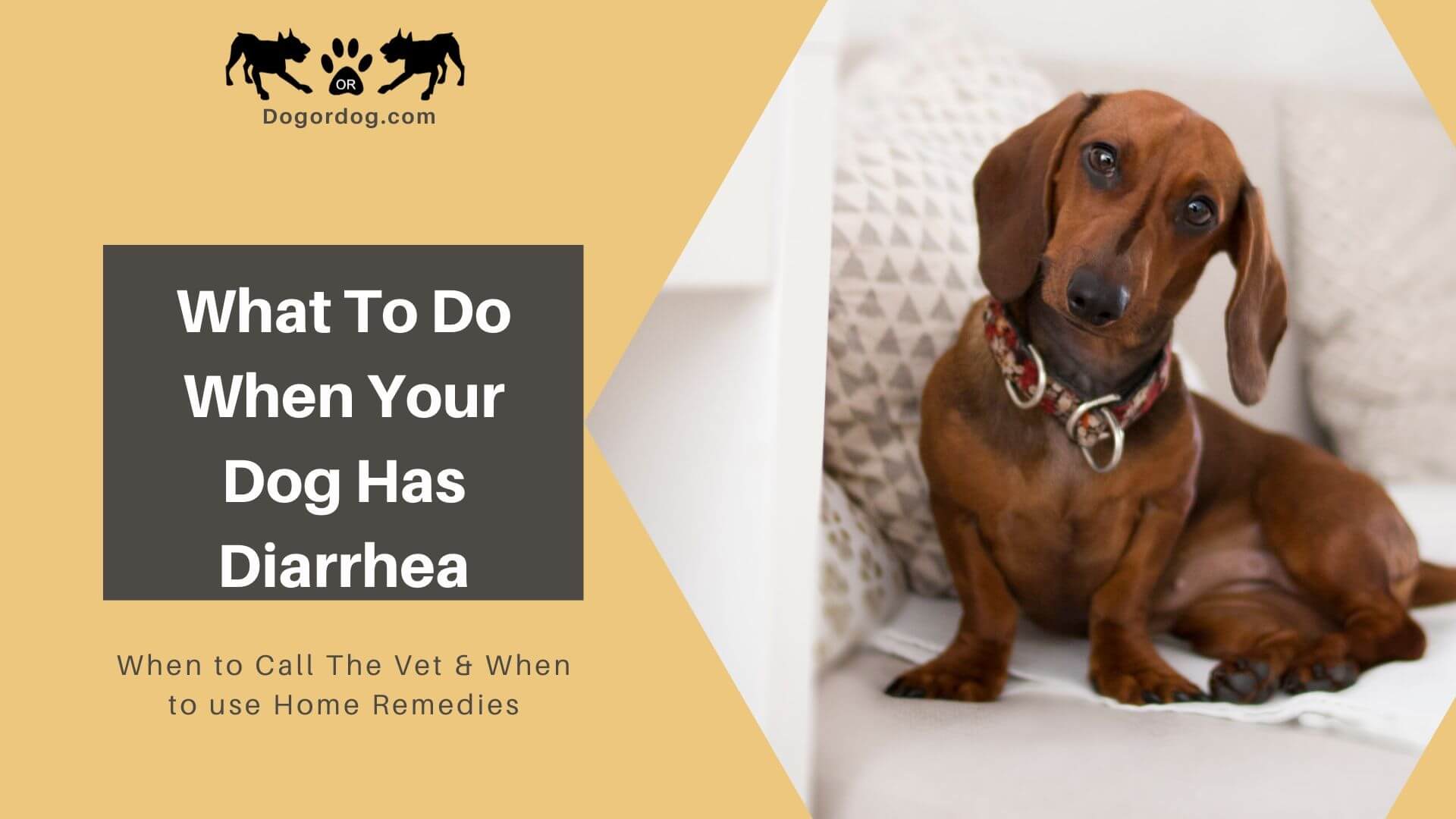
Diarrhea is common in dogs. In fact, it’s one of the most common complaints at the vet’s clinic. Diarrhea is not an ailment per se, but a symptom of a dysfunction of the gastrointestinal tract.
Your dog has a very resilient digestive system. They can eat almost anything and they’ll be completely fine. They can eat rotten carcasses, spoiled food, and even drink murky water, and they’ll still be fine.
This means if your dog has diarrhea, they must have eaten something really nasty or that there’s an underlying problem.
If your dog is suffering from frequent bowel movement or if you just adopted a dog for the first time, you need to know a few things about diarrhea so you can properly care for your pet.
But first, let’s discuss what could be the cause of your dog’s diarrhea in the first place.
Possible Causes of Diarrhea in Dogs
If your dog has diarrhea, the causes could be any of the following:
- Bacterial or viral infection
- Dietary Indiscretion (something they ate)
- Stress
- Introduction to a New Diet
- Inflammatory Bowel Disease
- Intolerance to Certain Food
Diarrhea is preventable and it’s paramount to note that you, as a pet owner, can take preventive measures so your dog doesn’t suffer in the first place.
Avoid feeding your dog spoiled food, table scraps, human food, and watch for small foreign objects lying around the floor.
All of these could cause problems in the intestinal tract that could lead to diarrhea.
How to Read Your Dog’s Poop
Dogs have a normal bowel movement of 1 to 2 bowels per day, and if they poop more than the average but they are active, eat and drink right, and display no other symptoms, it could mean it’s nothing you should be worried about.
If you’re unsure, however, you can read your dog’s poop to determine whether or not there’s a digestive issue.
Let’s compare the differences between a normal stool and an abnormal stool texture:
1. Normal Stool
- Formed but malleable
- Crumbly or chalky if the dog is on a raw food diet
- Frequency is 1 – 2 movements per day
2. Abnormal Stool
- Soft stool similar to soft-serve ice cream
- Loose stool that’s watery or thin stools
- Several movements per day, more than 2 times
You can also identify a problem through the color of your dog’s fecal matter.
1. Yellow
This normally indicates the presence of a bacterial infection, such as those caused by the parasite coccidia, pathogenic bacteria overgrowth, or changes in the liver (dog liver support remedy).
2. Green
Green stool could indicate a gallbladder problem (Urinary & Bladder Problems remedy) or your dog has eaten a lot of grass.
3. Orange
Orange stool is usually caused by food coloring and will disappear on its own.
4. Blue
If your dog’s poop is blue, bring him or her to the vet immediately. It could indicate that your dog has eaten rat poison.
5. Black
Black or dark brown stool usually means there’s blood in the poop.
6. Grey
Grey, greasy stools could mean there is a pancreas or biliary issue.
7. Pink or Red Specks
Pink or red specks could mean there is blood in the poop.
8. Mucus
While mucus is not a color, its presence determines that your dog’s digestive system is trying to get rid of something. Mucus is a detoxification response, and will usually disappear on its own.
You can get a stool sample of your dog’s poop and place it in a freezer. Double bag it, and bring it to the vet as soon as you can to check for intestinal parasites. This is one of the first steps in diagnosing your dog’s condition.
Homeopathic remedies to rejuvenate your pet
Our homeopathic remedies were formulated by our skilled homeopaths.
When to Call The Vet
A lot of dogs may suffer from diarrhea from time to time seeing that you can’t always control what they put in their mouth. Mild diarrhea can typically be cured at home using home remedies or over the counter meds, but in some cases, the symptoms could be severe and emergency treatment is needed as soon as possible.
This begs us the question, what are the symptoms you need to look out for? And when should you call the vet?
When diarrhea is accompanied by the following symptoms:
- Lethargy or lack of responsiveness
- Vomiting
- Blood or worms in the stool
- You suspect your dog ingested a foreign body such as a toy or piece of clothing
- Dog’s gums are discolored, pale, white, bluish, or grey
- Diarrhea has been going on for more than 24 hours
- Abdominal pain, bloating, or your dog is groaning, panting rapidly, and he won’t allow you to touch his belly
If any of these symptoms occur with diarrhea, bring him or her to the vet immediately. You never know any of these symptoms could be life-threatening so it’s best that you make sure your dog gets the emergency treatment he needs at once.
Home Remedies
When it comes to treating your dog’s diarrhea, you’ll want to avoid drugs and other chemical medications that can further damage your dog’s gut. Simple home remedies are readily available for many cases of diarrhea or even for acute diarrhea or you can use homeopathic remedies.
Here are a few home remedies that you can do:
1. Fast Your Dog
Let your dog’s gut rest and heal by not feeding him any food or water for 12 to 24 hours.
2. Rice Water
Continued diarrhea can lead to dehydration and weight loss. Since you can’t reintroduce solid foods just yet, rice water can do wonders to help deliver the fluids he needs.
Boil one cup of white rice in 4 cups of water. Remove the rice and serve the rice water to your dog as often he drinks it.
If he’s not interested, you can add small amounts of chicken baby food in the rice water to improve its flavor.
3. Probiotics
Probiotics are living bacterial cultures that assist the gut’s natural-occurring flora. It helps to reestablish healthy bacteria in the stomach, making recovery faster.
4. Over the Counter Medicine
If you must give your dog medicine, for your peace of mind, you can give him Imodium AD (Loperamide). It helps to reduce fluid loss by putting a stop to the bowel movement.
The recommended dosage is 2mg for each 40 to 45 pounds of body weight, to be administered two to 3 times daily.
However, it must be noted that Imodium stops the bowel movement but not the cause of diarrhea.
5. Reintroducing Food
If diarrhea has improved, you may want to reintroduce solid foods after 24 hours. However, it’s wise that you feed your dog a bland diet first.
You can feed him boiled chicken with white rice. Don’t add salt or seasoning to the chicken and drain off any residual fat. You can feed this diet until the next day, and you can go ahead to gradually feeding him his usual diet after.
Once you’ve given your canine friend these home remedies and tips, check his stool consistency to see if the texture of his poop has improved.
Related: Discover Your Dogʼs DNA Story for 170 genetic health conditions.
In Conclusion
Sometimes, it’s difficult to identify the signs of illness in your dog because they have a natural tendency to hide their illness for as long as possible, acting as if everything’s normal.
However, it is your responsibility as a dog owner to check on your dog’s health regularly. If you notice your dog is pooping more than usual, he lost his appetite, or if he looks weak, check his stool, and other symptoms that show you the signs of diarrhea.
While mild diarrhea can be resolved at home, you need to call the vet as soon as possible if the symptoms are more severe than usual.



